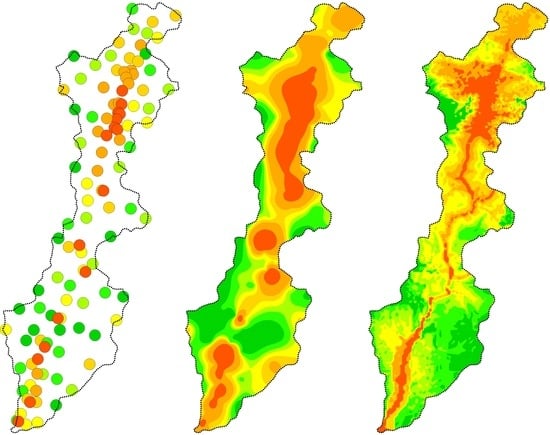Predicting the Spatial Distributions of Elements in Former Military Operation Area Using Linear and Nonlinear Methods Across the Stavnja Valley, Bosnia and Herzegovina †
Abstract
1. Introduction
2. Material and Methods
2.1. Description of the Study Area
2.2. Sampling Design, Sample Preparation, and Analytical Methods
3. Techniques used in Modelling
3.1. Data Processing
3.2. Data Transformation
3.3. Kriging
3.4. Artificial nNeural Network—Multilayer Perceptron
3.5. Multiple Polynomial Regressions
4. Results and Discussion
4.1. Linear Method (MPR) vs. Nonlinear Method (ANN-MLP)
4.2. Model Stability and Model Signification
4.3. Spatial Distribution of Pb
4.4. Spatial Distribution of Ti
4.5. ANN-MP Model Validation and Applicability in Various Case Studies
5. Conclusions
Author Contributions
Funding
Acknowledgments
Conflicts of Interest
Appendix A
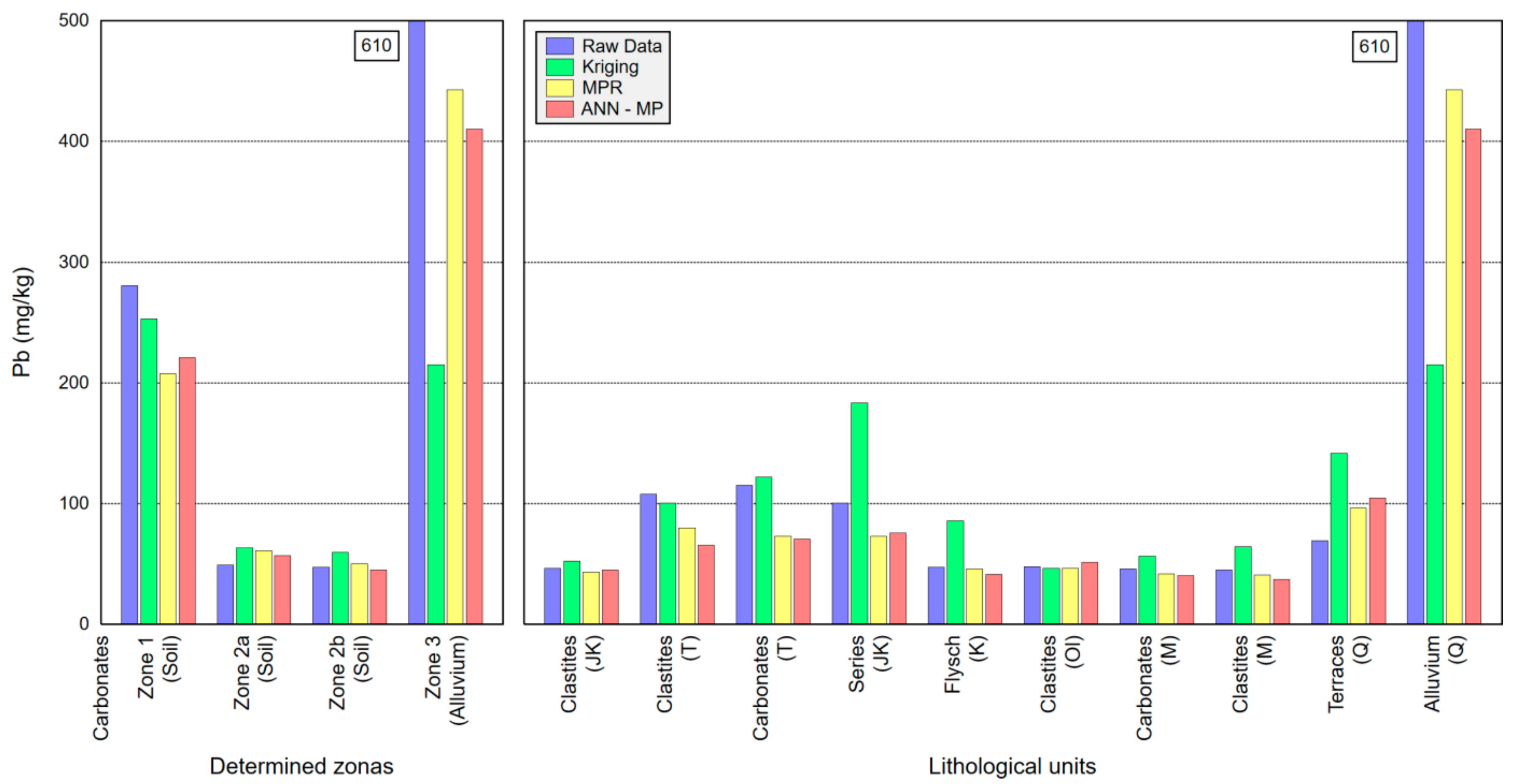
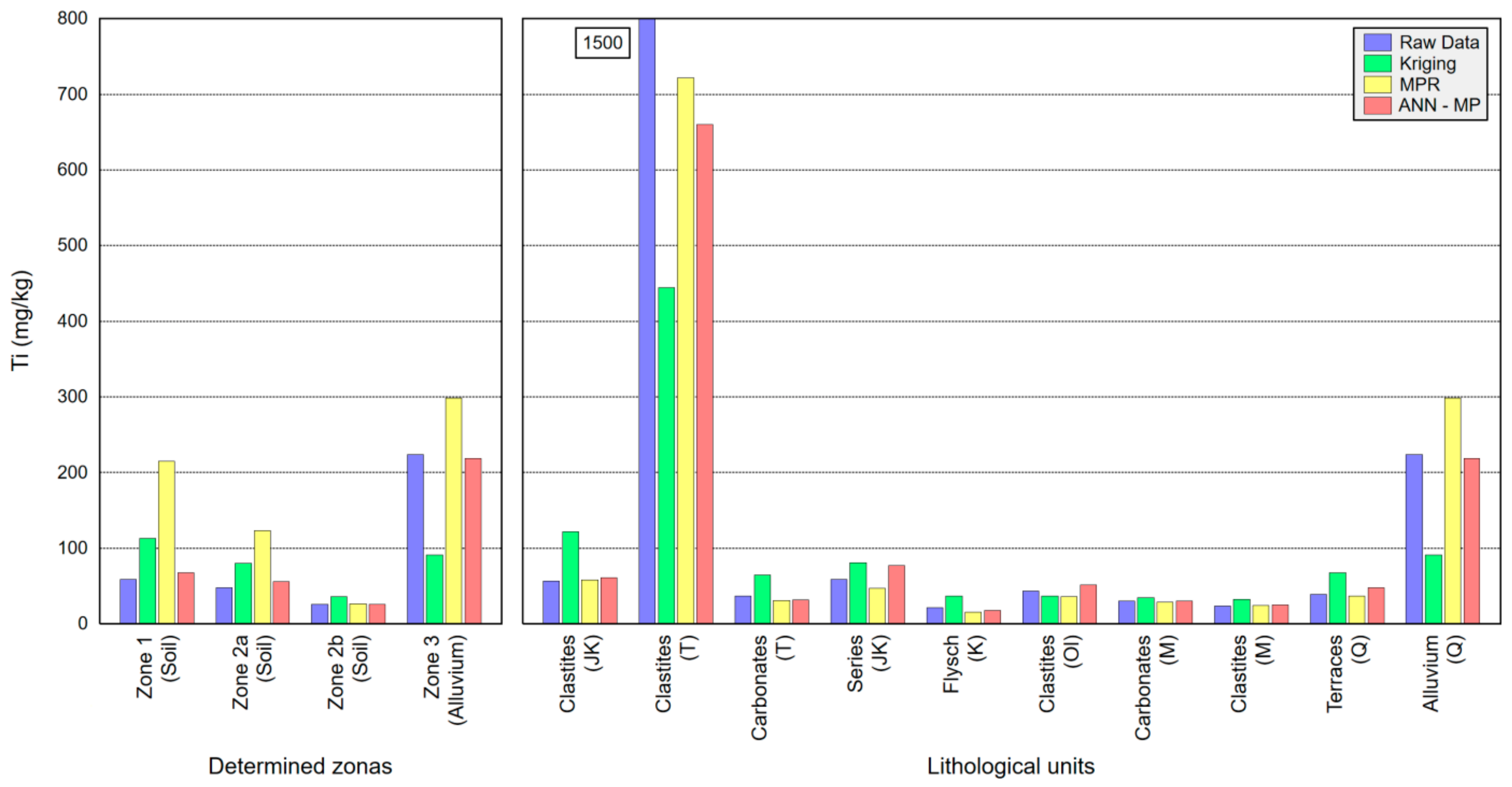
References
- Schumm, S.A. The Fluvial System; John Wiley & Sons: New York, NY, USA, 1977; 338p. [Google Scholar]
- Ferreira, V.; Koricheva, J.; Duarte, S.; Niyogi, D.K.; Guerold, F. Effects of anthropogenic heavy metal contamination on litter decomposition in streams—A meta-analysis. Environ. Pollut. 2016, 210, 261–270. [Google Scholar] [CrossRef] [PubMed]
- Šajn, R.; Halamić, J.; Peh, Z.; Galović, L.; Alijagić, J. Assessment of the natural and anthropogenic sources of chemical elements in alluvial soils from the Drava River using multivariate statistical methods. J. Geochem. Explor. 2011, 110, 278–289. [Google Scholar] [CrossRef]
- Yi, Q.; Dou, X.D.; Huang, Q.R.; Zhao, X.Q. Pollution Characteristics of Pb, Zn, As, Cd in the Bijiang River. Procedia Environ. Sci. 2012, 13, 43–52. [Google Scholar] [CrossRef]
- Zhao, X.; Dai, J.; Wang, J. GIS-based evaluation and spatial distribution characteristics of land degradation in Bijiang watershed. SpringerPlus 2013, 2, 1–8. [Google Scholar] [CrossRef][Green Version]
- Pavlowsky, R.T.; Lecce, S.A.; Owen, M.R.; Martin, D.J. Legacy sediment, lead, and zinc storage in channel and floodplain deposits of the Big River, Old Lead Belt Mining District, Missouri, USA. Geomorphology 2017, 299, 54–75. [Google Scholar] [CrossRef]
- Singh, K.P.; Basant, N.; Malik, A.; Jain, G. Modelling the performance of “up-flow anaerobic sludge blanket” reactor based wastewater treatment plant using linear and nonlinear approaches—A case study. Anal. Chim. Acta 2010, 658, 1–11. [Google Scholar] [CrossRef]
- Navarro, M.C.; Pérez-Sirvent, C.; Martínez-Sánchez, M.J.; Vidal, J.; Tovar, P.J.; Bech, J. Abandoned mine sites as a source of contamination by heavy metals: a case study in a semi-arid zone. J. Geochem. Explor. 2008, 96, 183–193. [Google Scholar] [CrossRef]
- Dudka, S.; Adriano, D.C. Environmental impacts of Metal Ore Mining and Processing: A Review. J. Environ. Qual. 1997, 26, 590–602. [Google Scholar] [CrossRef]
- Shallari, S.; Schwartz, C.; Hasko, A.; Morel, J.L. Heavy metals in soils and plants of serpentine and industrial sites of Albania. Sci. Total Environ. 1998, 209, 133–142. [Google Scholar] [CrossRef]
- Chopin, E.I.B.; Alloway, B.J. Distribution and mobility of trace elements in soils and vegetation around the mining and smelting areas of Tharsis, Ríotinto and Huelva, Iberian Pyrite Belt, SW Spain. Water Air Soil Pollut. 2007, 182, 245–261. [Google Scholar] [CrossRef]
- Al-Khashman, O.A.; Shawabkeh, R.A. Metal distribution in urban soil around steel industry beside Queen Alia Airport, Jordan. Environ. Geochem. Health 2009, 31, 717–726. [Google Scholar] [CrossRef] [PubMed]
- Budkovič, T.; Šajn, R.; Gosar, M. Environmental impact of active and abandoned mines and metal smelters in Slovenia. Geologija 2003, 46, 135–140. [Google Scholar] [CrossRef]
- Lee, C.H. Assessment of contamination load on water, soil and sediment affected by the Kongjujiel mine drainage, Republic of Korea. Environ. Geol. 2003, 44, 501–515. [Google Scholar] [CrossRef]
- Bhattacharya, P.; Ahmed, K.M.; Hasan, M.A.; Broms, S.; Fogelström, J.; Jacks, G.; Sracek, O.; Von Brömssen, M.; Routh, J. Mobility of arsenic in groundwater in a part of Brahmanbaria district, NE Bangladesh. In Managing Arsenic in the Environment: From Soils to Human Health; Naidu, R., Smith, E., Owens, G., Bhattacharya, P., Nadebaum, P., Eds.; CSIRO Publishing: Collingwood, Australia, 2006; pp. 95–115. [Google Scholar]
- Bretzel, F.; Calderisi, M. Metal contamination in urban soils of coastal Tuscany (Italy). Environ. Monit. Assess. 2006, 118, 319–335. [Google Scholar] [CrossRef]
- Gomes, M.E.P.; Favas, P.J.C. Mineralogical controls on mine drainage of the abandoned Ervedosa tin mine in north-eastern Portugal. Appl. Geochem. 2006, 21, 1322–1334. [Google Scholar] [CrossRef]
- Stafilov, T.; Šajn, R.; Pančevski, Z.; Boev, B.; Frontasyeva, M.V.; Strelkova, L.P. Heavy metal contamination of topsoils around a lead and zinc smelter in the Republic of Macedonia. J. Hazard. Mater. 2010, 175, 896–914. [Google Scholar] [CrossRef]
- Alijagić, J.; Šajn, R. Distribution of chemical elements in an old metallurgical area, Zenica (Bosnia and Herzegovina). Geoderma 2010, 162, 71–85. [Google Scholar]
- Khosravi, Y.; Zamanni, A.A.; Parizanganeh, A.H.; Yaftin, M.R. Assessment of spatial distribution pattern of heavy metals surrounding a lead and zinc production plant in Zanjan Province, Iran. Geoderma Reg. 2018, 12, 10–17. [Google Scholar] [CrossRef]
- McBratney, A.B.; Mendonça Santos, M.L.; Minasny, B. On digital soil mapping. Geoderma 2003, 117, 3–52. [Google Scholar] [CrossRef]
- Scull, P.; Franklin, J.; Chadwick, O.A.; McArthur, D. Predictive soil mapping: A review. Prog. Phys. Geogr. 2003, 27, 171–197. [Google Scholar] [CrossRef]
- Bagheri Bodaghabadi, M.; Martínez-Casasnovas, J.A.; Salehi, M.H.; Mohammadi, J.; Esfandiarpoor Borujeni, I.; Toomanian, N.; Gandomkar, A. Digital Soil Mapping Using Artificial Neural Networks and Terrain-Related Attributes. Pedosphere 2015, 25, 580–591. [Google Scholar] [CrossRef]
- Zhang, G.; Liu, F.; Song, X. Recent progress and future prospect of digital soil mapping: A review. J. Integr. Agric. 2017, 16, 2871–2885. [Google Scholar] [CrossRef]
- Lagacherie, P.; McBratney, A.B. Spatial soil information systems and spatial soil inference systems: Perspectives for Digital Soil Mapping. In Digital Soil Mapping—An Introductory Perspective, Developments in Soil Science; Lagacherie, P., McBratney, A.B., Voltz, M., Eds.; Elsevier: Amsterdam, The Netherlands, 2007; pp. 3–24. [Google Scholar]
- Alijagić, J. Application of multivariate statistical methods and artificial neural network for separation natural background and influence of mining and metallurgy activities on distribution of chemical elements in the Stavnja Valley (Bosnia and Herzegovina). Ph.D. Thesis, University of Nova Gorica, Nova Gorica, Slovenia, 2013. [Google Scholar]
- Hengl, T.; Heuvelink, G.B.M.; Rossiter, D.G. About regression-kriging: From equations to case studies. Comput. Geosci. 2007, 33, 1301–1315. [Google Scholar] [CrossRef]
- Mali, M.; Dell’Anna, M.M.; Rossiter, D.G.; Notarnicola, M.; Damiani, L.; Mastrorilli, P. Combining cheometric tools for assessing hazard sources and factors simultaneously in contaminated areas. Case study; “Mar Piccolo” Taranto (South Italy). Chemosphere 2017, 184, 784–794. [Google Scholar] [CrossRef]
- Pamić, J.; Pamić, O.; Olujić, J.; Milojević, R.; Veljković, D.; Kapeler, I. Basic Geological Map of SFRJ, Sheet Vareš 1:100.000 (Interpreter); Federal Geological Survey: Belgrade, Serbia, 1978; 68p.
- Palinkaš, L.A.; Šoštarić, S.B.; Palinkaš, S.S. Metallogeny of the Northwestern and Central Dinarides and Southern Tisia. Ore Geol. Rev. 2008, 34, 501–520. [Google Scholar] [CrossRef]
- Stafilov, T.; Šajn, R.; Boev, B.; Cvetković, J.; Mukaetov, D.; Andreevski, M.; Lepitkova, S. Distribution of some elements in surface soil over the Kavadarci region, Republic of Macedonia. Environ. Earth Sci. 2010, 61, 1515–1530. [Google Scholar] [CrossRef]
- Šajn, R. Using attic dust and soil for the separation of anthropogenic and geogenic elemental distributions in an old metallurgic area (Celje, Slovenia). Geochem. Explor. Environ. Anal. 2005, 5, 59–67. [Google Scholar] [CrossRef]
- Šajn, R. Factor analysis of soil and attic-dust to separate mining and metallurgy influence, Meža Valley, Slovenia. Math. Geol. 2006, 38, 735–747. [Google Scholar] [CrossRef]
- Salminen, R.; Batista, M.J.; Bidovec, M.; Demetriades, A.; De Vivo, B.; De Vos, W.; Duris, M.; Gilucis, A.; Gregorauskiene, V.; Halamić, J.; et al. Geochemical Atlas of Europe, Part 1, Background Information, Methodology and Maps; Geological Survey of Finland: Espoo, Finland, 2005; 526p. [Google Scholar]
- FAO. Guidelines for Soil Profile Descriptions, 4th ed.; FAO: Rome, Italy, 2006; 97p. [Google Scholar]
- ACME. Available online: http://acmelab.com (accessed on 15 September 2011).
- Google Earth Maps. Available online: http://earth.google.com (accessed on 17 February 2013).
- SRTM. Available online: http://srtm.csi.cgiar.org (accessed on 28 January 2013).
- Gringarten, E.; Deutsch, C.V. Teacher’s aide: Variogram interpretation and modelling. Math. Geol. 2001, 33, 507–534. [Google Scholar] [CrossRef]
- Krige, D.G. A statistical approach to some basic mine valuation problems on the Witwatersrand. J. Chem. Metall. Min. Soc. South Afr. 1951, 52, 119–139. [Google Scholar]
- Krige, D.G. On the departure of ore value distributions from lognormal models in South African gold mines. J. Chem. Metall. Min. Soc. South Afr. 1960, 61, 231–244. [Google Scholar]
- Rose, A.W.; Hawkes, H.E.; Webb, J.S. Geochemistry in Mineral Exploration, 2nd ed.; Academic Press: London, UK, 1979; 657p. [Google Scholar]
- Zhang, C.S.; Zhang, S.; Zhang, L.C.; Wang, L.J. Background contents of heavy metals in sediments of the Changjiang River system and their calculation methods. J. Environ. Sci. 1995, 7, 422–429. [Google Scholar]
- Zhang, C.S.; Selinus, O. Statistics and GIS in environmental geochemistry—Some problems and solutions. J. Geochem. Explor. 1998, 64, 339–354. [Google Scholar] [CrossRef]
- Box, G.E.P.; Cox, D.R. An analysis of transformations. J. R. Stat. Soc. Ser. B 1962, 26, 211–252. [Google Scholar] [CrossRef]
- Jobson, J.D. Applied Multivariate Data Analysis. Vol. I: Regression and Experimental Design; Springer-Verlag: New York, NY, USA, 1991; 662p. [Google Scholar]
- Zhang, C.S.; Zhang, S. A robust-symmetric mean: A new way of mean calculation for environmental data. Geo J. 1996, 40, 209–212. [Google Scholar] [CrossRef]
- Zhang, C.S.; Selinus, O.; Schedin, J. Statistical analyses on heavy metal contents in till and root samples in an area of southeastern Sweden. Sci. Total Environ. 1998, 212, 217–232. [Google Scholar] [CrossRef]
- McGrath, D.; Zhang, C.; Carton, O.T. Geostatistical analyses and hazard assessment on soil lead in Silvermines area, Ireland. Environ. Pollut. 2004, 127, 239–248. [Google Scholar] [CrossRef]
- Li, Y.; Zhu, A.; Shi, Z.; Liu, J.; Du, F. Supplemental sampling for digital soil mapping based on prediction uncertainty from both the feature domain and the spatial domain. Geoderma 2016, 284, 73–84. [Google Scholar] [CrossRef]
- Carlon, C.; Critto, A.; Marcomini, A.; Nathanail, P. Risk based characterisation of contaminated industrial site using multivariate and geostatistical tools. Environ. Pollut. 2001, 111, 417–427. [Google Scholar] [CrossRef]
- Theodossiou, N.; Latinopoulos, P. Evaluation and optimisation of groundwater observation networks using the Kriging methodology. Environ. Model. Softw. 2006, 21, 991–1000. [Google Scholar] [CrossRef]
- Webster, R.; Oliver, M.A. Geostatistics for Environmental Scientists; John Wiley and Sons Ltd.: Chichester, UK, 2001; 271p. [Google Scholar]
- Oliver, M.A.; Webster, R. A tutorial guide to geostatistics: Computing and modelling variograms and kriging. Catena 2014, 113, 56–69. [Google Scholar] [CrossRef]
- Žibret, G.; Šajn, R. Hunting for geochemical associations of elements: Factor analysis and self-organising maps. Math. Geol. 2010, 42, 681–703. [Google Scholar] [CrossRef]
- Rosenblatt, F. The perceptron: A probabilistic model for information storage and organization in the brain. Psychol. Rev. 1958, 65, 386–408. [Google Scholar] [CrossRef] [PubMed]
- ASCE. Available online: https://www.asce.org/ (accessed on 28 May 2010).
- Du, K.L.; Swamy, M.N.S. Neural Networks in an Softcomputing Framework; Springer–Verlag: London, UK, 2006; 566p. [Google Scholar]
- Agirre-Basurko, E.; Ibarra-Berastegi, G.; Madariaga, I. Regression and multilayer perceptron-based models to forecast hourly O3 and NO2 levels in the Bilbao area. Environ. Model. Softw. 2006, 21, 430–446. [Google Scholar] [CrossRef]
- Danandeh, M.A.; Nourani, V. A Pareto-optimal moving average-multigene genetic programming model for rainfall-runoff modelling. Environ. Model. Softw. 2017, 92, 239–251. [Google Scholar] [CrossRef]
- Žibret, G.; Šajn, R.; Alijagić, J.; Stafilov, T. Use of neural networks in the geochemical data interpretation. Zeitschrift für Geologische Wissenschaften 2012, 40, 253–266. [Google Scholar]
- Kelechi, A.C. Regression and Principal Component Analyses: A Comparison Using Few Regressors. Am. J. Math. Stat. 2012, 2, 1–5. [Google Scholar] [CrossRef]
- Ostertagová, E. Modelling using polynomial regression. Procedia Eng. 2012, 48, 500–506. [Google Scholar] [CrossRef]
- Kerrou, J.; Deman, G.; Tacher, L.; Benabderrahmane, H.; Perrochet, P. Numerical and polynomial modelling to assess environmental and hydraulic impacts of the future geological radwaste repository in Meuse site (France). Environ. Model. Softw. 2017, 97, 157–170. [Google Scholar] [CrossRef]
- Stat Soft, Inc. STATISTICA (Data Analysis Software System), Version 11–Software; Stat Soft, Inc.: Tulsa, OK, USA, 2012; Available online: www.statsoft.com (accessed on 30 January 2020).
- Golden Software, Inc. Surfer (Surface Mapping System), Ver 11–Software; Golden Software, Inc.: Golden, CO, USA, 2012. Available online: http://www.goldensoftware.com (accessed on 30 January 2020).
- Abdi-Khangha, M.; Bemani, A.; Naserzadeh, Z.; Zhang, Z. Prediction of solubility of N-alkanes in supercritical CO2 using RBF-ANN and MLP-ANN. J. CO2 Util. 2018, 25, 108–119. [Google Scholar] [CrossRef]
- Meloun, M.; Sanka, M.; Nemec, P.; Kritkova, S.; Kupka, K. The analysis of soil cores polluted with certain metals using the Box–Cox transformation. Environ. Pollut. 2005, 137, 273–280. [Google Scholar] [CrossRef] [PubMed]
- Cabrera-Arcega, F.; Armienta, M.A.; Daessle, L.W.; Castillo-Blum, S.E.; Talavera, O.; Dotor, A. Variations of Pb in a mine-impacted tropical river, Taxco, Mexico: Use of geochemical, isotopic and statistical tools. Appl. Geochem. 2009, 24, 162–171. [Google Scholar] [CrossRef]
- Alijagić, J.; Šajn, R.; Rokavec, D. Impact assessment of mining and metallurgical activities on the distribution of trace elements in the Stavnja Valley, Bosnia and Herzegovina. In Advances in Environmental Research; Daniels, J.A., Ed.; Nova Science Publishers: New York, NY, USA, 2015; pp. 139–200. [Google Scholar]
- Stafilov, T.; Šajn, R.; Alijagić, J. Distribution of Arsenic, Antimony and Thallium in Soil in Kavadarci and the Environs, Republic of Macedonia. Soil Sediment Contam. 2013, 22, 105–118. [Google Scholar] [CrossRef]

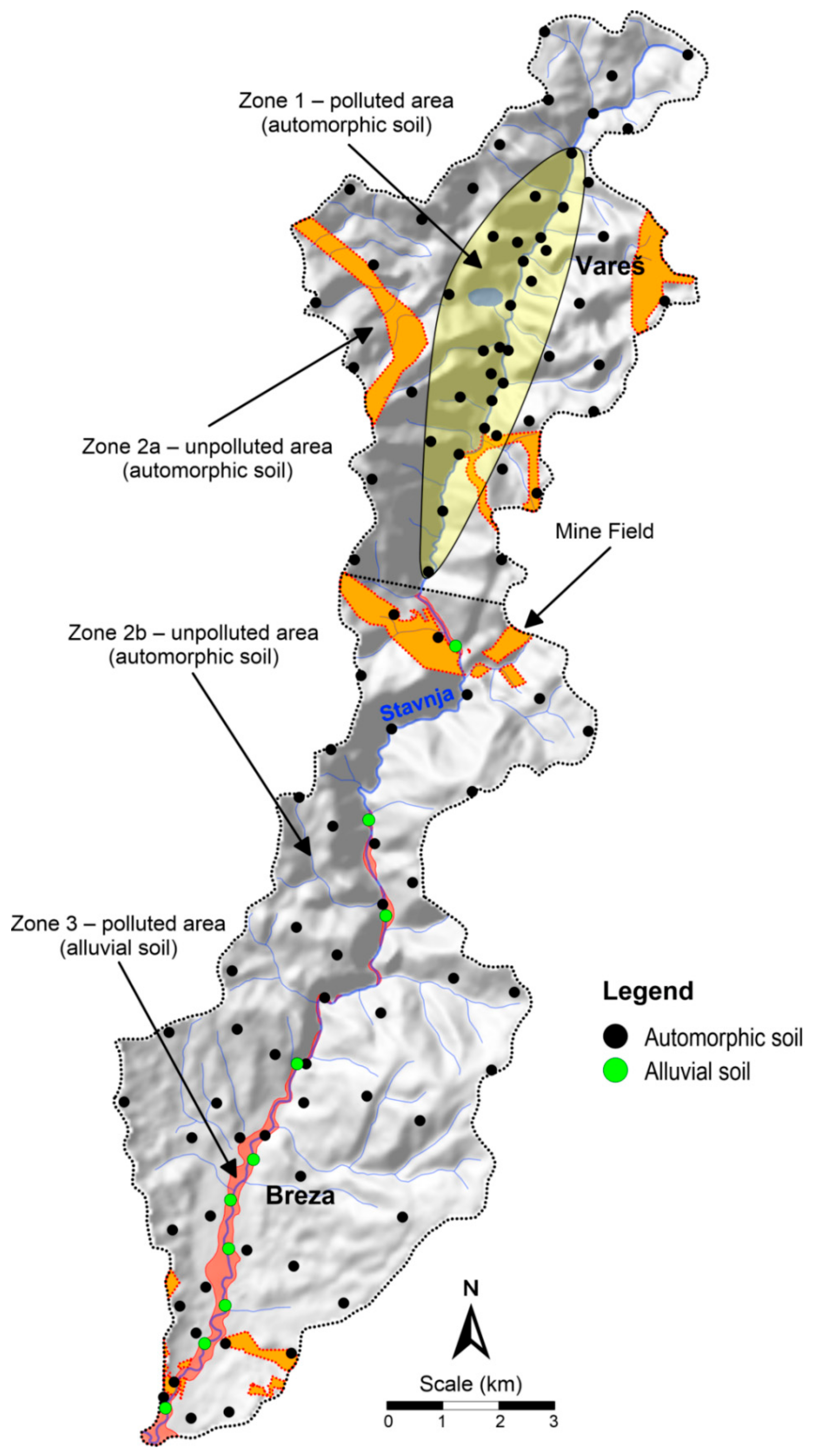
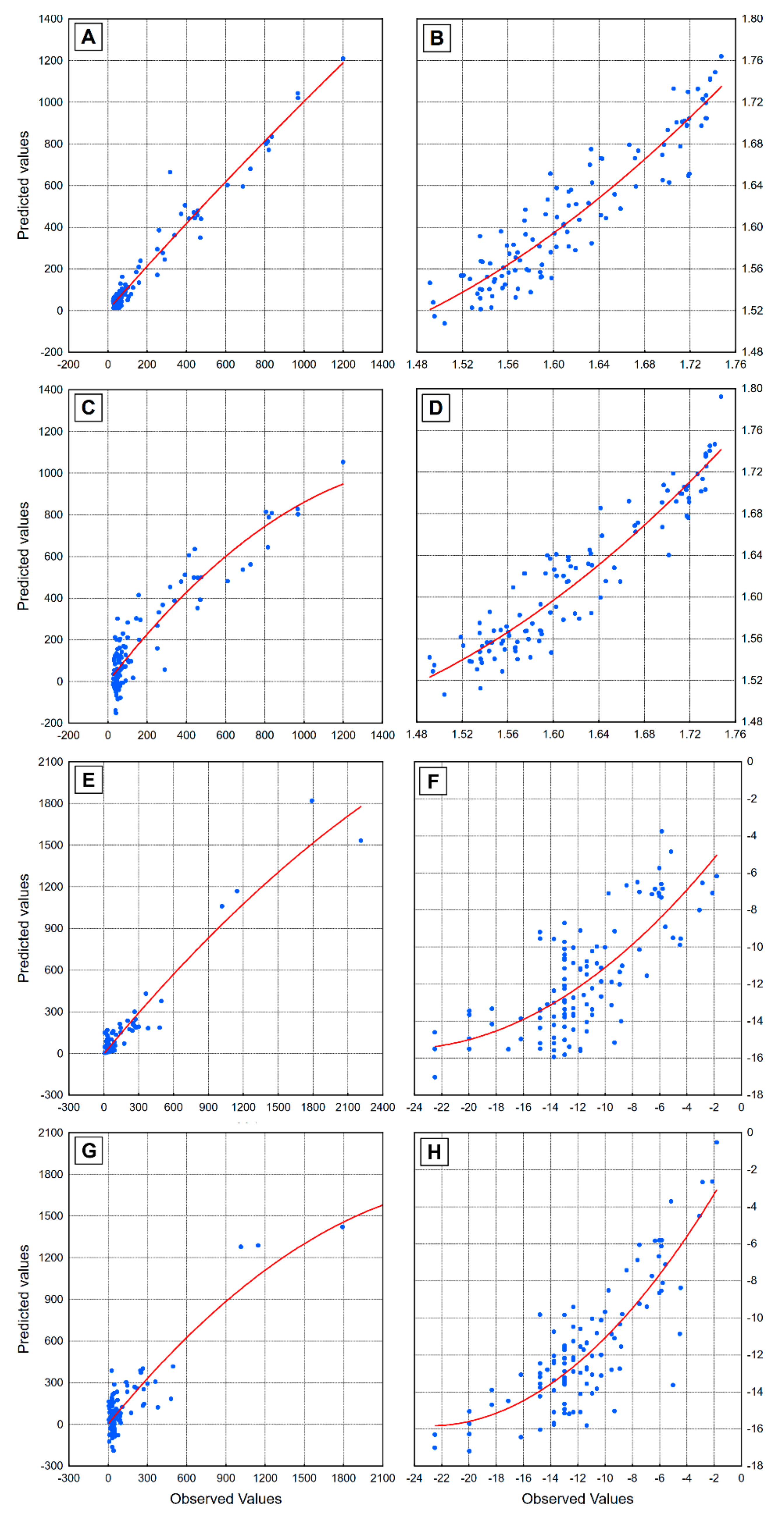
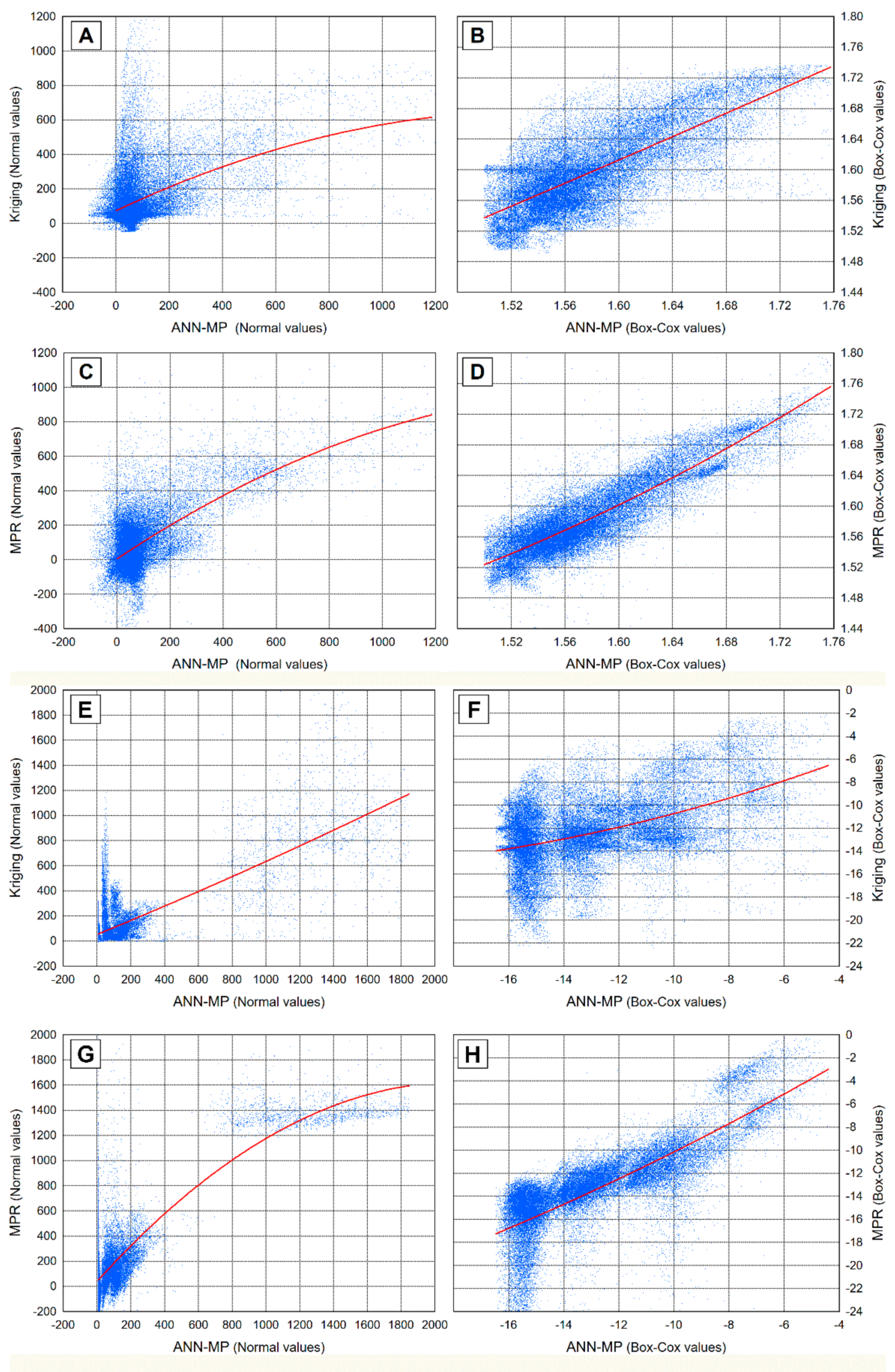
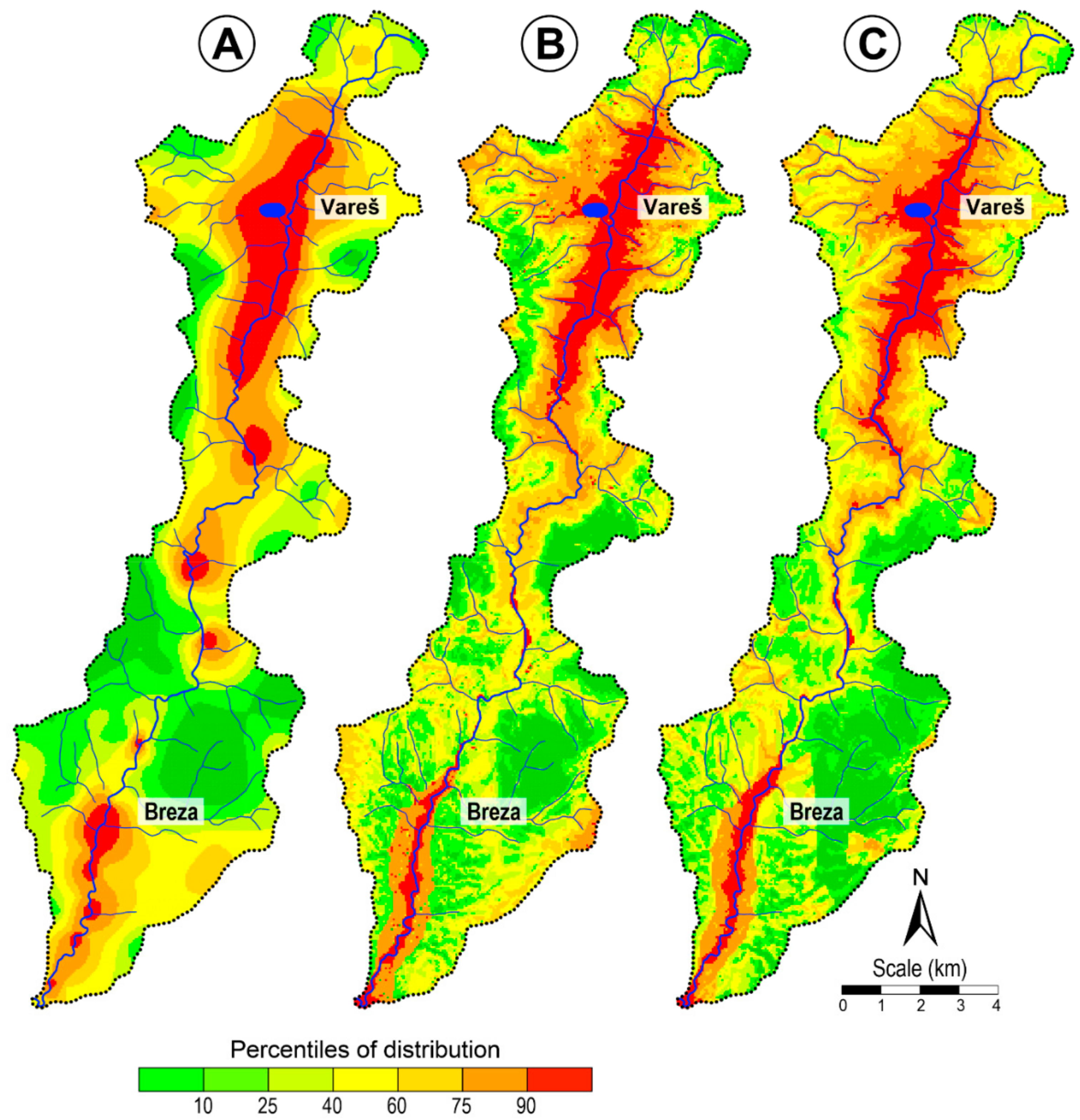
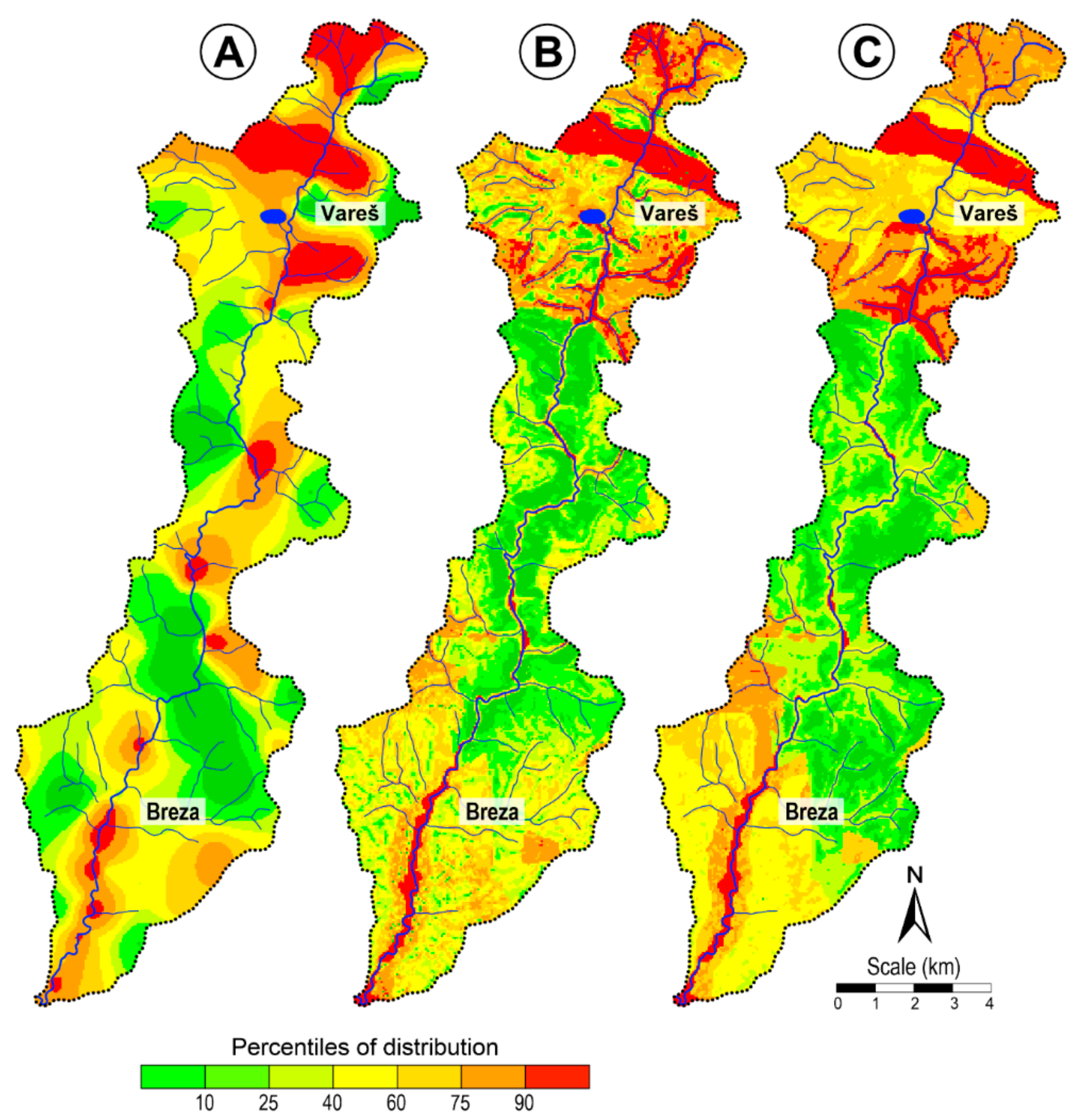
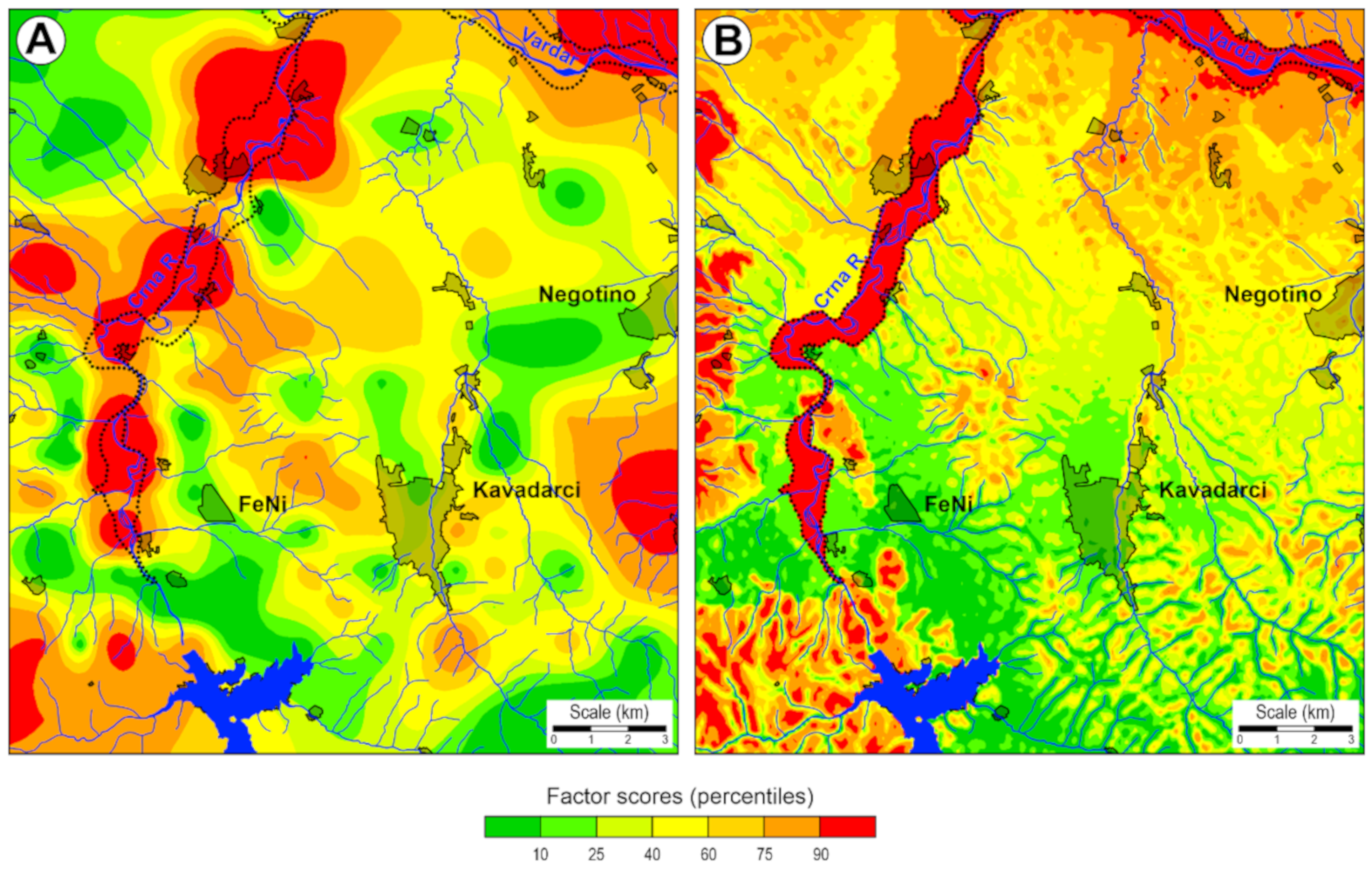
| Element | Transformation | X¯ | Md | A | E | X2 | KS |
|---|---|---|---|---|---|---|---|
| Pb (N) | Raw values | 190 | 62 | 2.66 * | 8.13 * | 139.2 * | 0.32 * |
| Pb (B) | Box-Cox | 72 | 62 | 0.37 NS | −0.20 NS | 28.7 NS | 0.11 NS |
| Ti (N) | Raw values | 130 | 35 | 5.02 * | 28.02 * | 109.4 * | 0.34 * |
| Ti (B) | Box-Cox | 42 | 35 | −0.11 NS | 0.50 NS | 16.6 NS | 0.12 NS |
| MPR | ||||
| Element | Multiple R | Multiple R2 | Adjusted R2 | F Ratio |
| Pb (N) | 0.93 | 0.86 | 0.81 | 16.9 |
| Pb (B) | 0.94 | 0.87 | 0.83 | 18.6 |
| Ti (N) | 0.78 | 0.60 | 0.45 | 4.0 |
| Ti (B) | 0.90 | 0.82 | 0.75 | 11.8 |
| ANN-MP | ||||
| Element | Training Perfection | Test Perfection | Validation Perfection | All Perfection |
| Pb (N) | 0.93 | 0.91 | 0.94 | 0.92 |
| Pb (B) | 0.99 | 0.98 | 0.89 | 0.98 |
| Ti (N) | 0.79 | 0.87 | 0.73 | 0.80 |
| Ti (B) | 0.96 | 0.87 | 0.95 | 0.94 |
© 2020 by the authors. Licensee MDPI, Basel, Switzerland. This article is an open access article distributed under the terms and conditions of the Creative Commons Attribution (CC BY) license (http://creativecommons.org/licenses/by/4.0/).
Share and Cite
Alijagić, J.; Šajn, R. Predicting the Spatial Distributions of Elements in Former Military Operation Area Using Linear and Nonlinear Methods Across the Stavnja Valley, Bosnia and Herzegovina. Minerals 2020, 10, 120. https://doi.org/10.3390/min10020120
Alijagić J, Šajn R. Predicting the Spatial Distributions of Elements in Former Military Operation Area Using Linear and Nonlinear Methods Across the Stavnja Valley, Bosnia and Herzegovina. Minerals. 2020; 10(2):120. https://doi.org/10.3390/min10020120
Chicago/Turabian StyleAlijagić, Jasminka, and Robert Šajn. 2020. "Predicting the Spatial Distributions of Elements in Former Military Operation Area Using Linear and Nonlinear Methods Across the Stavnja Valley, Bosnia and Herzegovina" Minerals 10, no. 2: 120. https://doi.org/10.3390/min10020120
APA StyleAlijagić, J., & Šajn, R. (2020). Predicting the Spatial Distributions of Elements in Former Military Operation Area Using Linear and Nonlinear Methods Across the Stavnja Valley, Bosnia and Herzegovina. Minerals, 10(2), 120. https://doi.org/10.3390/min10020120





